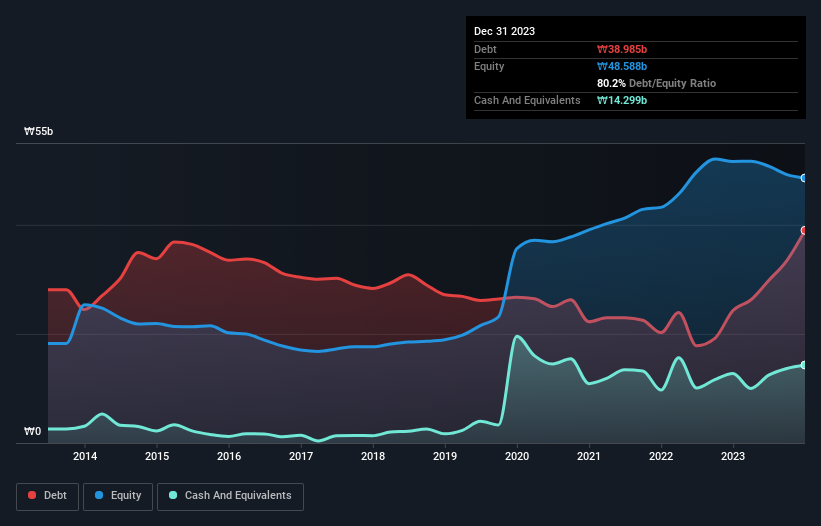- South Korea
- /
- Semiconductors
- /
- KOSDAQ:A171010
Here's Why Ram Technology (KOSDAQ:171010) Can Afford Some Debt
Warren Buffett famously said, 'Volatility is far from synonymous with risk.' So it might be obvious that you need to consider debt, when you think about how risky any given stock is, because too much debt can sink a company. As with many other companies Ram Technology Co., Ltd (KOSDAQ:171010) makes use of debt. But is this debt a concern to shareholders?
When Is Debt A Problem?
Debt and other liabilities become risky for a business when it cannot easily fulfill those obligations, either with free cash flow or by raising capital at an attractive price. Ultimately, if the company can't fulfill its legal obligations to repay debt, shareholders could walk away with nothing. However, a more frequent (but still costly) occurrence is where a company must issue shares at bargain-basement prices, permanently diluting shareholders, just to shore up its balance sheet. By replacing dilution, though, debt can be an extremely good tool for businesses that need capital to invest in growth at high rates of return. The first step when considering a company's debt levels is to consider its cash and debt together.
View our latest analysis for Ram Technology
How Much Debt Does Ram Technology Carry?
As you can see below, at the end of December 2023, Ram Technology had ₩39.0b of debt, up from ₩24.3b a year ago. Click the image for more detail. However, because it has a cash reserve of ₩14.3b, its net debt is less, at about ₩24.7b.

How Strong Is Ram Technology's Balance Sheet?
The latest balance sheet data shows that Ram Technology had liabilities of ₩33.5b due within a year, and liabilities of ₩10.3b falling due after that. On the other hand, it had cash of ₩14.3b and ₩2.24b worth of receivables due within a year. So its liabilities outweigh the sum of its cash and (near-term) receivables by ₩27.3b.
This deficit isn't so bad because Ram Technology is worth ₩83.9b, and thus could probably raise enough capital to shore up its balance sheet, if the need arose. However, it is still worthwhile taking a close look at its ability to pay off debt. There's no doubt that we learn most about debt from the balance sheet. But you can't view debt in total isolation; since Ram Technology will need earnings to service that debt. So if you're keen to discover more about its earnings, it might be worth checking out this graph of its long term earnings trend.
In the last year Ram Technology had a loss before interest and tax, and actually shrunk its revenue by 36%, to ₩43b. That makes us nervous, to say the least.
Caveat Emptor
Not only did Ram Technology's revenue slip over the last twelve months, but it also produced negative earnings before interest and tax (EBIT). To be specific the EBIT loss came in at ₩3.0b. Considering that alongside the liabilities mentioned above does not give us much confidence that company should be using so much debt. So we think its balance sheet is a little strained, though not beyond repair. However, it doesn't help that it burned through ₩12b of cash over the last year. So suffice it to say we consider the stock very risky. There's no doubt that we learn most about debt from the balance sheet. However, not all investment risk resides within the balance sheet - far from it. For instance, we've identified 5 warning signs for Ram Technology (2 are a bit concerning) you should be aware of.
If, after all that, you're more interested in a fast growing company with a rock-solid balance sheet, then check out our list of net cash growth stocks without delay.
New: AI Stock Screener & Alerts
Our new AI Stock Screener scans the market every day to uncover opportunities.
• Dividend Powerhouses (3%+ Yield)
• Undervalued Small Caps with Insider Buying
• High growth Tech and AI Companies
Or build your own from over 50 metrics.
Have feedback on this article? Concerned about the content? Get in touch with us directly. Alternatively, email editorial-team (at) simplywallst.com.
This article by Simply Wall St is general in nature. We provide commentary based on historical data and analyst forecasts only using an unbiased methodology and our articles are not intended to be financial advice. It does not constitute a recommendation to buy or sell any stock, and does not take account of your objectives, or your financial situation. We aim to bring you long-term focused analysis driven by fundamental data. Note that our analysis may not factor in the latest price-sensitive company announcements or qualitative material. Simply Wall St has no position in any stocks mentioned.
About KOSDAQ:A171010
Ram Technology
Engages in the manufacturing and selling of electronic chemical materials in South Korea.
Low risk and slightly overvalued.
Market Insights
Community Narratives




